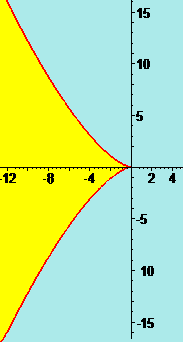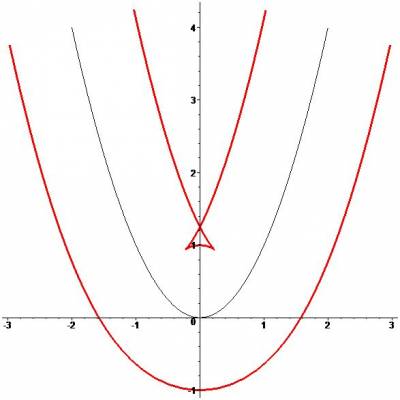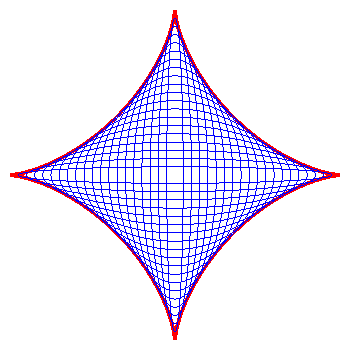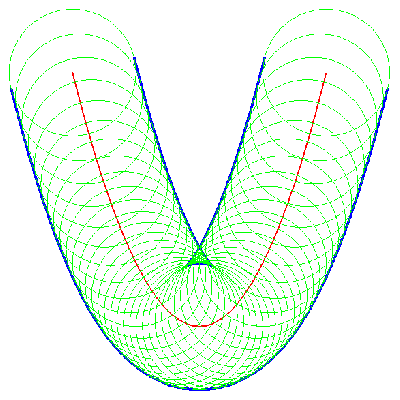Основное
Содержание
Discriminant
Denote by $ \mathbb A_{} $ any of the sets $ \mathbb Z_{}, \mathbb Q, \mathbb R $ or $ \mathbb C_{} $.
Discriminant1) of the polynomial $$ f(x)=a_{0}x^n+a_1x^{n-1}+\dots+a_n, \ (n>1, a_0\ne 0) $$ coincides with the resultant of this polynomial and its derivative: $$ {\mathcal D}(f)=\frac{(-1)^{n(n-1)/2}}{a_0}{\mathcal R}(f(x),f^{\prime}(x)) \ . $$
Theorem. If $ \lambda_{1},\dots,\lambda_n $ denotes the zeros of $ f_{}(x) $ counted with their multiplicities, then
$$ {\mathcal D}(f) =(-1)^{n(n-1)/2} a_0^{n-2}\prod_{j=1}^n f^{\prime}(\lambda_j)= a_0^{2n-2} \prod_{1\le j < k \le n} (\lambda_k - \lambda_j)^2 \ . $$
$ {\mathcal D}(f_{}) = 0 $ iff $ f_{}(x) $ possesses a multiple zero.
Example. For the quadratic polynomial one has
$$ {\mathcal D}(a_0x^2+a_1x+a_2)=\frac{1}{a_0}\left|\begin{array}{ccc} a_0&a_1&a_2\\ 0&2a_0&a_1\\ 2a_0&a_1&0 \end{array}\right|=a_1^2-4\,a_0a_2 \ . $$
Prove the following:
a) $ \displaystyle {\mathcal D}(x^{3}+p\,x+q)=-108\left(\frac{q^2}{4}+\frac{p^3}{27}\right) $;
b) $ {\mathcal D}(a_{0}x^3+a_1x^2+a_2x+a_3)= a_1^2a_2^2-4a_1^3a_3-4\,a_0a_2^3+18\,a_0a_1a_2a_3-27\,a_0^2a_3^2 $;
c) $ \displaystyle {\mathcal D}(x^{4}+px+q)=6912\left(\frac{q^3}{27}-\frac{p^4}{256}\right) $.
Example. If $ a_0 \ne 0 $ then
$${\mathcal D} (a_0x^4+a_1x^3+a_2x^2+a_3x+a_4)=4I_2^3-27I_3^2 \ . $$ Here $$ I_2=4a_0a_4-a_1a_3 +\frac{1}{3}a_2^2 \ , $$ $$ I_3=-a_0a_3^2-a_1^2a_4+\frac{8}{3}a_0a_2a_4+ \frac{1}{3}a_1a_2a_3-\frac{2}{27}a_2^3 $$ stand for the invariants of the quartic polynomial.
Properties
1. $$ {\mathcal D}(A\cdot f(x)) = A^{2n-2} {\mathcal D}(f) ; $$ here $ A_{} $ stands for a constant and $ \deg f = n_{}>1 $.
2. $$ {\mathcal D}(f(x)\cdot g(x))={\mathcal D}(f){\mathcal D}(g)\left[{\mathcal R}(f, g) \right]^2 \ ; $$ here $ {\mathcal R}(f, g_{}) $ denotes the resultant of the polynomials $ f(x)_{} $ and $ g_{}(x) $; and it is assumed that $ \deg f> 1_{} $ and $ \deg g> 1_{} $.
3. $$ {\mathcal D}(f(x)(x-a))={\mathcal D}(f)\left[f(a) \right]^2 \ . $$ 4. If $ a_{0}\ne 0, a_n \ne 0 $ then $$ {\mathcal D}(a_0x^n+a_1x^{n-1}+\dots+a_n)={\mathcal D}(a_0+a_1x+\dots+a_{n-1}x^{n-1}+a_nx^n) $$
5. $$ {\mathcal D}(f(g(x))=\left[{\mathcal D}(f) \right]^m \prod_{j=1}^n {\mathcal D}(g(x)-\lambda_j) \ ; $$ here $ n=\deg f, m=\deg g $, $ \lambda_{1},\dots,\lambda_n $ stand for the zeros of $ f_{}(x) $, and the leading coefficients of $ f_{}(x) $ and $ g_{}(x) $ are assumed to be equal $ 1_{} $.
Express
a) $ {\mathcal D}(f_{}(A\,x+B)) $; b) $ {\mathcal D}(f(x^{m})) $; c) $ {\mathcal D}( {\tilde f}_{}(x)) $
via $ {\mathcal D}(f)_{} $. Here $$ {\tilde f}(x)\equiv (C\,x+D)^n f\left(\frac{A\,x+B}{C\,x+D} \right) \ . $$
Determinantal representation
According to the definition, the discriminant can be represented as the $ (2n-1)_{} $-th odrer determinant: $$ {\mathcal D}(f) $$ $$ =\frac{1}{a_0} \left|\begin{array}{cccccccccc} a_0&a_1&a_2&\ldots&\ldots&a_n&0&\dots &0 &0\\ 0&a_0&a_1&\ldots&\ldots&a_{n-1}&a_n&\dots&0 &0\\ \vdots&&\ddots&&&&&&\ddots\\ 0&0&\ldots&a_0&a_1&\ldots & & \ldots &a_{n-1} &a_n\\ 0&0&\ldots&&na_0&(n-1)a_1&\ldots& \ldots &2a_{n-2}&a_{n-1}\\ 0&0&\ldots&na_0&(n-1)a_1&\ldots &&\ldots &a_{n-1}&0\\ \vdots&&&\ldots&&&& &&\vdots\\ 0&na_0&\ldots&\ldots&&a_{n-1}&\ldots&&\ldots&0\\ na_0&\ldots&\ldots&&a_{n-1}&0&\ldots&&&0 \end{array}\right| \begin{array}{l} \left.\begin{array}{l} \\ \\ \\ \\ \end{array}\right\} n-1 \\ \left. \begin{array}{l} \\ \\ \\ \\ \\ \end{array}\right\} n \end{array} $$ Using the elementary transformation of its rows one can reduce it to the $ (2n-2)_{} $-th order determinant: $$ {\mathcal D}(f) $$ $$ =\frac{1}{n^{n-2}} \left|\begin{array}{cccccccc} a_1&2a_2&3a_3&\ldots&na_n&0&\ldots&0\\ 0& a_1&2a_2&3a_3&\ldots&na_n&\ldots&0\\ & & &\ldots&\ldots& & & \\ 0&\ldots&0&a_1&2a_2&3a_3&\ldots&na_n\\ 0&\ldots&0&na_0&(n-1)a_1&(n-2)a_2&\ldots&a_{n-1}\\ 0&\ldots&na_0&(n-1)a_1&(n-2)a_2&\ldots&a_{n-1}&0\\ & & &\ldots&\ldots& & & \\ na_0&(n-1)a_1&(n-2)a_2&\ldots&a_{n-1}&0 &\ldots&0 \end{array}\right| $$ The last determinant can be obtained from an alternative definition of the discriminant. Consider a homogeneous bivariate polynomial (form) in $ x_{} $ and $ y_{} $: $$ F(x,y)= a_0x^n + a_1x^{n-1}y +a_2x^{n-2}y^2+\dots+a_{n-1}xy^{n-1}+a_ny^n . $$ Compute its partial derivatives $$ \phi(x,y)=\partial F / \partial x ,\ \psi(x,y)=\partial F / \partial y \ . $$ The discriminant of $ F(x,y)_{} $ is taken to be equal the resultant of $ \psi(x,1)_{} $ and $ \phi(x,1)_{} $.
Discriminant as a function in the polynomial coefficients
By definition, the discriminant is a homogeneous polynomial over $ \mathbb Z_{} $ in the coefficients $ a_{0},\dots,a_n $ of the polynomial $ f_{}(x) $: $$ {\mathcal D}(a_0x^n+\dots+a_n)\equiv D(a_0,\dots,a_n) \in {\mathbb Z}[a_0,\dots,a_n] \ ;$$ one has $ \deg D= 2n-2_{} $ and this polynomial in $ a_{0},\dots,a_n $ contains the term $ (-1)^{n(n-1)/2}n^n a_{0}^{n-1}a_n^{n-1} $.
Theorem [Jacobi]. If $ f(x)_{} $ possesses a unique multiple zero $ \lambda_{} $ and its multiplicity equals $ 2_{} $ then
$$ 1 : \lambda : \lambda^2 : \dots : \lambda^n = \frac{\partial D}{\partial a_n} : \frac{\partial D}{\partial a_{n-1}} : \frac{\partial D}{\partial a_{n-2}} : \dots : \frac{\partial D}{\partial a_{0}} \, . $$
Example. Deduce the general formula for the double zero for
$$ f(x)=a_{0}x^4+a_1x^3+a_2x^2+a_3x+a_4, \ a_0\ne 0 $$ under the assumption of its uniqueness.
Solution. Using the formula for the discriminant of the quartic polynomial ( v. ☝ ABOVE ), one gets: $$\lambda = -\frac{2\,a_1I_2^2+9\,(-2\,a_0a_3+1/3\, a_1a_2)I_3}{8\,a_0I_2^2-9\,I_3(-a_1^2+8/3\,a_0a_2)} \ . $$
For $ f(x)= x^{4}-5x^3+4x^2+3x+9 $ one has $ I_{2}=169/3, I_3=-4394/27 $, $ {\mathcal D}(f)=0_{} $ and formula from the above theorem yields $ \lambda_{} = 3 $. ♦
Subdiscriminants
The determinant obtained from $$ \left|\begin{array}{cccccccc} a_1&2a_2&3a_3&\ldots&na_n&0&\ldots&0\\ 0& a_1&2a_2&3a_3&\ldots&na_n&\ldots&0\\ & & &\ldots&\ldots& & & \\ 0&\ldots&0&a_1&2a_2&3a_3&\ldots&na_n\\ 0&\ldots&0&na_0&(n-1)a_1&(n-2)a_2&\ldots&a_{n-1}\\ 0&\ldots&na_0&(n-1)a_1&(n-2)a_2&\ldots&a_{n-1}&0\\ & & &\ldots&\ldots& & & \\ na_0&(n-1)a_1&(n-2)a_2&\ldots&a_{n-1}&0 &\ldots&0 \end{array}\right| $$ by deleting its $ k_{} $ first rows and its $ k_{} $ last rows, $ k_{} $ first columns and $ k_{} $ last columns we will call the $ k_{} $-th subdiscriminant of the discriminant $ \mathcal D (f_{}) $ and will denote by $ {\mathcal D}_{k} $. For the convenience of presentation of some results we will take the zero subdiscriminant to be equal the determinant itself, i.e. $$ {\mathcal D}_0=n^{n-2}{\mathcal D} (f) \quad and \quad {\mathcal D}_{n-1} = 1 \ . $$
Theorem. The polynomial $ f_{}(x) $ possesses exactly $ d_{} $ common zeros with its derivative (or, more strictly, $ \deg( \gcd (f,f^{\prime}))=d_{} $) iff
$$ \underbrace{{\mathcal D}_0=0, {\mathcal D}_1=0,\dots, {\mathcal D}_{d-1}=0}_d,{\mathcal D}_d\ne 0 \ . $$
If $ f(x)_{} $ possesses a unique multiple zero $ \lambda_{} $ and its multiplicity equals $ 2_{} $ then this zero can be expessed as a rational function of the coefficients of the polynomial
$$ \lambda=-\frac{\tilde {\mathcal D}_1}{{\mathcal D}_1} \ , $$ here $ \tilde {\mathcal D}_{1} $ stands for the determinant obtained from $ {\mathcal D}_{0} $ by deleting its first and its last row, and its first and its last-but-one column (thus $ \tilde {\mathcal D}_{1} $ differs from $ {\mathcal D}_{1} $ only in its last column).
Example. Find all the values of the parameter $ \alpha_{} $ under which the polynomial
$$ f(x)=2\,x^5+3\,x^4+4\,x^3+x^{2}-\alpha $$ possesses a unique multiple zero; compute this zero.
Solution. Compute the determinant $ {\mathcal D}_{0} $: $$ {\mathcal D}_0=\left|\begin{array}{rrrrrrrr} 3 & 8 & 3 & 0 & -5 \alpha & 0 & 0 & 0 \\ 0 & 3 & 8 & 3 & 0 & -5 \alpha & 0 & 0 \\ 0 & 0 & 3 & 8 & 3 & 0 & -5 \alpha & 0 \\ 0 & 0 & 0 & 3 & 8 & 3 & 0 & -5 \alpha \\ 0 & 0 & 0 & 10 & 12 & 12 & 2 & 0 \\ 0 & 0 & 10 & 12 & 12 & 2 & 0 & 0 \\ 0 & 10 & 12 & 12 & 2 & 0 & 0 & 0 \\ 10 & 12 & 12 & 2 & 0 & 0 & 0 & 0 \end{array} \right| $$ $$ =50000\,\alpha^4-100608\,\alpha^3+51216\,\alpha^2-608\,\alpha \ . $$ This polynomial in $ \alpha_{} $ vanishes iff $ \alpha_{} \in \{0,1, 38/3125 \} $. Deleting from $ {\mathcal D}_{0} $ its boundary rows and columns one gets $$ {\mathcal D}_1=\left|\begin{array}{rrrrrr} 3 & 8 & 3 & 0 & -5 \alpha & 0 \\ 0 & 3 & 8 & 3 & 0 & -5 \alpha \\ 0 & 0 & 3 & 8 & 3 & 0 \\ 0 & 0 & 10 & 12 & 12 & 2 \\ 0 & 10 & 12 & 12 & 2 & 0 \\ 10 & 12 & 12 & 2 & 0 & 0 \end{array} \right| = 110000\,\alpha^2-102400\,\alpha-7600 \ . $$ Substitution for $ \alpha_{} $ the values discovered above yields: $$ {\mathcal D}_1 \ne 0 \ for \ \alpha \in \{0, 38/3125 \}; \ {\mathcal D}_1 = 0 \ for \ \alpha =1 \ . $$ Consequently $ f_{}(x) $ possesses a unique double zero iff $ \alpha_{} \in \{0, 38/3125 \} $, while for $ \alpha_{} =1 $ it has either several multiple zeros or a zero of multiplicity higher than $ 2_{} $. For the evaluation of the multiple zero, compute the determinant $ \tilde {\mathcal D}_{1} $: $$ \tilde {\mathcal D}_1=\left|\begin{array}{rrrrrr} 3 & 8 & 3 & 0 & -5 \alpha & 0 \\ 0 & 3 & 8 & 3 & 0 & 0 \\ 0 & 0 & 3 & 8 & 3 & -5 \alpha \\ 0 & 0 & 10 & 12 & 12 & 0 \\ 0 & 10 & 12 & 12 & 2 & 0 \\ 10 & 12 & 12 & 2 & 0 & 0 \end{array} \right| = 147000\alpha^2-147000\alpha \ , $$ and substitute into the formula $$ \lambda=- \tilde {\mathcal D}_1 / {\mathcal D}_1 $$ the obtained values for $ \alpha_{} $: $$ \lambda = 0 \ \ for \ \alpha =0 ; \ \lambda = -1/5 \ \ for \ \alpha = 38/3125 \ . $$ ♦
Representation of the discriminant via the Hankel determinant
For the polynomial $ f_{}(x) $ its $ k_{} $-th Newton sum is defined as the sum of $ k_{} $-th powers of its zeros $$ s_k=\sum_{j=1}^n\lambda_j^k \ . $$ Newton sums can be expressed as rational functions of the coefficients of $ f_{}(x) $ with the aid of the following recursive Newton formulas: $$s_0=n,\ s_1=-a_1/a_0,\ $$ $$ s_k=\left\{\begin{array}{lr} -(a_1s_{k-1}+a_2s_{k-2}+\dots+a_{k-1}s_1+a_kk)/a_0, & if \ k\le n ;\\ -(a_1s_{k-1}+a_2s_{k-2}+\dots+a_ns_{k-n})/a_0, & if \ k > n \end{array} \right. $$ Explicit expressions for the Newton sums via $ a_{0}, \dots, a_n $ are given by the Waring formula.
Compute the Newton sums $ s_{0},s_1,\dots,s_{2n-2} $ for $ f_{}(x) $ and compose the Hankel matrix $$ S=\left[s_{j+k} \right]_{j,k=0}^{n-1} = \left[\begin{array}{llllll} s_0 &s_1&s_2&\dots&s_{n-2}& s_{n-1}\\ s_1 &s_2&s_3&\dots&s_{n-1}& s_{n}\\ s_2 &s_3&s_4&\dots&s_{n}& s_{n+1}\\ \dots& & &&& \dots\\ s_{n-1} &s_n&s_{n+1}&\dots &s_{2n-3}&s_{2n-2} \end{array}\right]_{n\times n} \ . $$ Denote by $ S_{1},\dots, S_n $ its leading principal minors.
Theorem. The followng formula connects the minors of the matrix $ S_{} $ with the subdiscriminants of the polynomial $ f(x)_{} $:
$$ {\mathcal D}_{k}=n^{n-k-2}a_0^{2(n-k-1)}S_{n-k} \ . $$ In particular, $$ {\mathcal D}(f)=a_0^{2n-2}\det S \ . $$
Proof follows from the repesentation for $ \mathcal R(f_{},f^{\prime}) $ in the Kronecker form.
If $ S_n=0, S_{n-1}\ne 0 $ then $ f(x) $ possesses a unique multiple zero and the multiplicity of this zero equals $ 2 $. This zero is computed via the formula
$$ \lambda = s_1-\frac{1}{S_{n-1}} \left| \begin{array}{lllll} s_0 & s_1 & \dots & s_{n-3} & s_{n-1} \\ s_1 & s_2 & \dots & s_{n-2} & s_{n} \\ \vdots & & & & \vdots \\ s_{n-2} & s_{n-1} & \dots & s_{2n-1} & s_{2n-3} \end{array} \right| \, . $$ The determinant in the right-hand side is constructed by deleting the last row and the last but one column in $ \det S $.
Discriminant ifluence on the polynomial zeros
Closeness of zeros
Theorem. The following estimations are valid
$$ \frac{\sqrt{\left|{\mathcal D}(f) \right|}}{(2\rho)^{n(n-1)/2-1}|a_0|^{n-1}} \le \min_{j,k\in \{1,\dots,n \} \atop j\ne k} \left|\lambda_j - \lambda_k \right| \le \frac{\left|{\mathcal D}(f)\right|^{1/[n(n-1)]}}{|a_0|^{2/n}} \quad for \quad \rho = \max_{j \in \{1,\dots,n \}} |a_j| \ . $$
Solution of algebraic equations by radicals
In the middle school course in Algebra the following formula is known for the expression of the zeros of a quadric polynomial $ f(x)=a_{0}x^2+a_1x+a_2=0 $ as functions of its coefficients: $$ \lambda_{1,2}=\frac{-a_1\pm\sqrt{{\mathcal D}(f)}}{2a_0} \ . $$ Here $ {\mathcal D}(f)=a_{1}^2-4a_0a_2 $ is the discriminant of the quadric polynomial. While initially introduced for the quadric with real coefficients and for the case $ {\mathcal D}(f) \ge 0_{} $, the formula remains also valid for the case of imaginary coefficients.
For the cubic equation $ f(x)=a_{0}x^3+a_1x^2+a_2x+a_3=0 $, there also exists a formula for the explicit representation of polynomial zeros via coefficients — namely, Cardano's formula. In a particular case of a polynomial $ f(x)=x^{3}+px+q $, this formula is $$ \lambda = \sqrt[3]{-\frac{q}{2}+\sqrt{\frac{q^2}{4}+\frac{p^3}{27}}}+ \sqrt[3]{-\frac{q}{2}-\sqrt{\frac{q^2}{4}+\frac{p^3}{27}}} \ . $$ There is a special agreement [3] for combining the values of the cubic roots in the above sum (generally the radicands are imaginary numbers even for the case of real $ p_{} $ and $ q_{} $). One may notice that the radicand of the square root coincides with the discriminant: $$ \frac{q^2}{4}+\frac{p^3}{27} = -108 {\mathcal D}(x^3+px+q) \ . $$
Reality of zeros
Polynomial $ f(x)=a_0x^{n}+a_1x^{n-1}+\dots+a_{n} $ with real coefficients $ a_{0}\ne 0, a_1,\dots a_n $ may possess both real and non-real (imaginary) zeros $ \lambda_{1},\dots,\lambda_n $. Although these zeros cannot be expressed in «good» functions from the polynomial coefficients, the conditions for the existence of the prescribed number of real zeros can be expressed in terms of polynomial inequalities imposed on $ a_{0}, a_1,\dots a_n $. The «most essential» from these inequalities is the one imposed on the sign of the discriminant $ {\mathcal D}(f_{}) $.
Example. The necessary and sufficient condition for the reality of all the zeros of the polynomial
a) $ f(x)=a_{0}x^2+a_1x+a_{2} $ is $ {\mathcal D}(f)=a_1^2-4a_0a_{2} \ge 0 $;
b) $ f(x)=x^{3}+p\,x+q_{} $ is $ {\mathcal D}(f) = -4\,p^3-27\,q^{2} \ge 0 \ \iff \ \frac{q^2}{4}+\frac{p^3} {27} \le 0 $.
For the polynomial of the degree $ n \ge 4_{} $, the nonnegativity of discriminant is not the necessary and sufficient condition for the reality of all the polynomial zeros.
Theorem. For the reality of all the zeros of $ f(x)_{} $ it is necessary that $ {\mathcal D}(f) \ge 0_{} $.
Proof evidently follows from the representation of $ \mathcal D (f)_{} $ via the zeros of $ f(x)_{} $.
The more general result connects the number of distinct zeros of $ f(x)_{} $ with the signs of subdiscriminants.
Theorem. Let $ {\mathcal D}(f) \ne 0_{} $. If the sequence of subdiscriminants
$$ {\mathcal D}_0,{\mathcal D}_{1},\dots,{\mathcal D}_{n-1}=1 $$ does not contain two consecutive zeros, then all the zeros of the polynomial $ f(x)_{} $ are distinct and the number of real zeros equals $$ {\mathcal P}(1,{\mathcal D}_{n-1},\dots,{\mathcal D}_0) - {\mathcal V}(1,{\mathcal D}_{n-1},\dots,{\mathcal D}_0) \ . $$ Here $ {\mathcal P} $ and $ {\mathcal V} $ stand for correspondingly the number of permanences and the number of variations of signs in the considered sequence.
The previous theorem is just a reformulation of the following result based on the representaion of the discriminant as the determinant of the Hankel matrix $ S_{} $.
Theorem [Jacobi]. The number of distinct zeros of a polynomial $ f(x)_{} $ equals the rank, while the number of distinct real zeros of $ f(x)_{} $ equals the signature of the matrix $ S_{} $.
The constructive computation of the rank and the signature of a symmetric matrix $ S_{} $ is possible via evaluation of the signs of its leading principal minors $ S_{1},\dots,S_n $.
Let
$$ S_n=0,\dots,S_{{\mathfrak r}+1}=0,S_{\mathfrak r}\ne 0, \dots, S_1 \ne 0 \ .$$ Then $ \operatorname{rank} (S)={\mathfrak r}_{} $ and the number of distinct real zeros of $ f(x)_{} $ equals $${\mathcal P}(1,S_1,\dots,S_{\mathfrak r}) -{\mathcal V}(1,S_1,\dots,S_{\mathfrak r}) \ . $$
For the reality of all the zeros of $ f(x) \in \mathbb R[x]_{} $ it is necessary and sufficient that all the leading principal minors of the matrix $ S_{} $ be positive: $$ S_1>0,\dots,S_n > 0 \ . $$
Example. Find the number of real zeros of $ x^{5}-3\,x^3-x-1 $.
Solution. Newton sums: $$ \{s_j \}_{j=0}^8=\{5,\, 0,\, 6,\, 0,\, 22,\, 5,\, 72,\, 21,\,238 \} \ . $$ Compose the Hankel matrix: $$ S= \left[ \begin{array}{rrrrr} 5 & 0 & 6 & 0 & 22 \\ 0 & 6 & 0 & 22 & 5 \\ 6 & 0 & 22 & 5 & 72 \\ 0 & 22 & 5 & 72 & 21 \\ 22 & 5 & 72 & 21 & 238 \end{array} \right] $$ and compute its leading principal minors: $$ S_1=5,\, S_2=30,\, S_3=444,\, S_4=-4598,\, S_5=-56\,123 \ . $$ Since $ S_{5}\ne 0 $, all the zeros of $ f(x)_{} $ are distinct. $$ {\mathcal P}(1,\,5,\,30,\,444,\,-4598,\,-56\,123)=4,\ {\mathcal V}(1,\,5,\,30,\,444,\,-4598,\,-56\,123)=1 \ . $$
Answer. Three real zeros.
Example. Find the number of real zeros of the polynomial
$$ 2\,x^{5}+3\,x^4+4\,x^3+x^{2}-{\color{Red} \alpha } $$ in dependency of the parameter $ {\color{Red} \alpha } \in \mathbb R $.
Solution. The discriminant of the polynomial and its first subdiscriminant have been already computed above: $$ {\mathcal D}_0= 16\alpha(3125\,{\color{Red} \alpha }-38)({\color{Red} \alpha }-1)^2,\ {\mathcal D}_1=400\,(275\,{\color{Red} \alpha }+19)({\color{Red} \alpha }-1) \ . $$ $$ {\mathcal D}_2=\left|\begin{array}{rrrr} 3 & 8 & 3 & 0 \\ 0 & 3 & 8 & 3 \\ 0 & 10 & 12 & 12 \\ 10 & 12 & 12 & 2 \end{array} \right| = -2940 \ , {\mathcal D}_3=\left|\begin{array}{rr} 3 & 8 \\ 10 & 12 \end{array} \right|=-44 \ . $$ Analyze the signs of $ {\mathcal D}_{0} $ and $ {\mathcal D}_{1} $ under the variation of parameter $ {\color{Red} \alpha } $; the critical values for the latter are those annihilating at least one of subdiscriminants: $$ \begin{array}{c|c|c|c} & {\mathcal D}_0 & {\mathcal D}_1 & \begin{array}{l} {\mathcal P}(1,1,{\mathcal D}_3,{\mathcal D}_2, {\mathcal D}_1,{\mathcal D}_0) - \\ {\mathcal V}(1,1,{\mathcal D}_3,{\mathcal D}_2, {\mathcal D}_1,{\mathcal D}_0) \end{array} \\ \hline {\color{Red} \alpha }>1 & >0 & <0 & 3-2 \\ \hline \frac{38}{3125}<{\color{Red} \alpha }<1 & >0 & <0 & 3-2 \\ \hline 0<{\color{Red} \alpha }<\frac{38}{3125} & <0 & <0 & 4-1 \\ \hline -\frac{19}{275} < {\color{Red} \alpha } < 0 & >0 & <0 & 3-2 \\ \hline {\color{Red} \alpha } < -\frac{19}{275} & >0 & >0 & 3-2 \end{array} $$
Answer. Polynomial possesses one real zero if $ {\color{Red} \alpha }<0_{} $ and if $ {\color{Red} \alpha } > 38/3125 $; polynomial possesses three real zero if $ {\color{Red} \alpha } \in [0,38/3125] $.
Theorem. In the $ n_{} $-dimensional parameter space $ (a_{1},\dots, a_n) $, the domains corresponding to the polynomials $ f(x)=x^n+a_1x^{n-1}+\dots+a_{n} $ with equal number of real zeros, are separated by the discriminant manifold, i.e. the surface defined by
$$D(1,a_1,\dots,a_n) = \mathcal D_x(x^n+a_1x^{n-1}+\dots + a_n)=0 \ . $$
Example.  For the polynomial $ x^{3}+px+q $ the discriminant manifold becomes a curve in the $ (p,q) $-plane: $ 4\,p^3+27\,q^2 =0 $;
it separates the domain for the parameter values corresponding to polynomials with three real zeros
(обозначена in yellow) frome the domain of values defining the polynomials with precisely one real zero (in blue).
For the polynomial $ x^{3}+px+q $ the discriminant manifold becomes a curve in the $ (p,q) $-plane: $ 4\,p^3+27\,q^2 =0 $;
it separates the domain for the parameter values corresponding to polynomials with three real zeros
(обозначена in yellow) frome the domain of values defining the polynomials with precisely one real zero (in blue).
Applications
Critical values of a polynomial
Problem. For the polynomial $ f(x)=a_0x^{n}+a_1x^{n-1}+\dots+a_n $ with real coefficients $ a_0\ne 0, a_{1},\dots a_n $, evaluate its critical values. In particular, for an even $ n_{} $ and for $ a_{0}<0 $, find the absolute maximum $$ \max_{x\in {\mathbb R}}f(x) \ . $$
Theorem. The critical values of the polynomial $ f_{}(x) $ are the real zeros of the polynomial
$$ {\mathcal F}(z)={\mathcal D}_x(f(x)-z) \ . $$ Here the discriminant is treated with respect to the variable $ x_{} $, while $ z_{} $ is tackled as a numerical parameter.
For an even $ n_{} $ and $ a_{0}<0 $, the maximal value of $ f_{}(x) $ coincides with the maximal real zero of the polynomial $ {\mathcal F}(z_{}) $ provided that this zero is not a multipe one.
Example. For $ f(x)=x^{4}+p\,x+q $ one has
$${\mathcal F}(z)=256\ z^3-768q\ z^2+768q^2\ z+(27 p^4-256 q^3) \ .$$
Example. Find the maximum of the polynomial
$$ f(x)=-x^{6}+12\,x^2+12\,x+2 \, . $$
Solution. One has $$ \mathcal F(z)= 46656(-z^5+10\,z^4+472\,z^3+16208\,z^2-16272\,z-32800)\ , $$ maximal real zero of the last polynomial $ \approx 35.6321_{} $ coincides with the value of $ f_{}(x) $ at a zero of its derivative: $ \mu_{} \approx 1.51851 $. ♦
Construct the polynomial $ {\mathcal F}_{}(z) $ for
(a) $ f(x)=-x^{4}-4x^3+2x^2+12x $,
(b) $ f(x)=-x^{4}+4x^3-4x^2 $,
( c) $ f(x)=-x^{6}-10x^3+12 x $
and establish that $ \max f_{}(x) $ is attained at two stationary points of $ f_{}(x) $.
The importance of the simplicity condition for the maximal zero of $ {\mathcal F}(z) $ is clarified by the following example:
Example. [5]. For
$$ f(x)=-x^{6}-135x^2-324x $$ one gets the polynomial $$ {\mathcal F}(z)= 46656(z^3+1080\,z^2+1603800\,z-354294000)(z-540)^2 $$ that possesses the maximal zero $ z_{}=540 $; however, the latter corresponds to the nonreal zeros $ \mu_{1,2}=(-3\pm \mathbf i\sqrt {15})/2_{} $ of the derivative $ f{'}(x)=-6(x^{5}+45\,x+54) $. Maximum for $ f_{}(x) $ is attained at the zero $ \mu_{3}=1-\sqrt[3]{10} $ and it equals $ 90(-4+5 \sqrt[3]{10}-\sqrt[3]{100}_{}) \approx 191.7526154 $. ♦
Critical values of an implicit function
Let us generalize the problem from the previous section:
Problem. Find critical values of the function $ y=f_{}(x) $ defined implicitly by the algebraic equation $ \Phi_{}(x,y)=0 $. Here $ \Phi_{}(x,y) $ is a polynomial in $ x_{} $ and $ y_{} $ with real coefficients.
Theorem. Critical values of the implicit function are among the real zeros of the polynomial
$$ {\mathcal F}(y)={\mathcal D}_x(\Phi(x,y)) \ . $$ Here the discriminant is considered with respect to $ x_{} $, while $ y_{} $ is assumed to be a numerical parameter.
Proof. The necessary condition for the existence of a stationary point for $ y=f_{}(x) $ at $ x=x_{0} $ consists in vanishing the derivative $ f^{\prime}(x_{}) $. Differentiating the identity $ \Phi(x,f(x)) \equiv 0 $ as to $ x_{} $ $$ \frac{\partial \Phi}{\partial x} + \frac{\partial \Phi}{\partial y} f^{\prime}(x) \equiv 0 $$ we conclude that at $ x=x_0, y_0=f(x_0) $ the conditions have to be fulfilled: $$ \Phi(x,y)=0,\ \partial \Phi / \partial x = 0 \ . $$ ♦
Example. Find the mimimal value of the implicit function given by
$$ -x^4-1/2 y^4+4\,x^2+3\,xy+4\,y=0 \ \mbox{ for } \ y < 0, x\in ]-2,2[ \ . $$
Solution. We ignore here the questions of existence and representations for this function; but apply the theorem as it is: $$ {\mathcal F}(y)={\mathcal D}_x(-x^4+4\,x^2+3\,xy-1/2 y^4+4\,y) = $$ $$ =32\,y^{12}-768\,y^9-512\,y^8+3552\,y^6+8192\,y^5-139\,y^4+4352\,y^3-30464\,y^2-16384\,y \ . $$ The real zeros of this polynomial are: $$ y_1 \approx -1.795011, \ y_2 \approx -0.490598, \ y_3= 0,\ y_4 \approx 2.741399 \ . $$ The minimal zero is $ y_{1} $; with its value, one can restore the corresponding $ x_{1} $ — as a multiple zero for $ \Phi (x,y_1) $. Its value $ x_1 \approx -1.674506 $ lies within the demanded interval $ ]-2,2[ $, and one can additionally verify that for $ x = \pm 2 $ the real zeros of $ \Phi(x_{},y) $ are greater than $ y_{1} $.
Answer. $ \min \approx -1.795011 $.
Distance evaluation
Theorem[6,7]. The square of the distance to the quadric $ {\mathbb R}^{n} $ given by the equation
$$ X^{\top}AX+2\,B^{\top}X-1=0 \ , (A=A^{\top}) $$ from the point $ X_{0} \in {\mathbb R}^n $ not lying in the quadric (i.e. $ X_{0}^{\top}AX_0+2 B^{\top}X_0-1\ne 0 $) equals the minimal positive zero of the distance equation $$ {\mathcal F}(z)={\mathcal D}_{\mu} (\Phi(\mu,z))=0 \ , $$ provided that the mentioned zero is not a multiple one. Here $$ \Phi(\mu,z)=\det \left( \left[ \begin{array}{cc} A & B \\ B^{\top} & -1 \end{array} \right] + \mu \left[ \begin{array}{cc} -I & X_0 \\ X_0^{\top} & z-X_0^{\top}X_0 \end{array} \right] \right) $$ while $ {\mathcal D}_{} $ stands for the discriminant of the polynomial (treated w.r.t. $ \mu $), and $ I_{} $ is the identity matrix of the order $ n_{} $.
The square of the distance from $ {\mathbb O} \in {\mathbb R}^{n} $ to the quadric in $ {\mathbb R}^{n} $ given by the equation
$$ X^{\top}AX+2B^{\top}X-1=0 \ , $$ equals the minimal positive zero of the distance equation $$ {\mathcal F}(z)={\mathcal D}_{\mu} \left( f(\mu)(\mu z-1)-B^{\top}\operatorname{adj}(A,\mu)B \right)=0\ , $$ provided that this zero is simple. Here $ f(\mu)=\det (A-\mu I) $ is the characteristic polynomial of the matrix $ A_{} $ while $ \operatorname{adj}(A,\mu) $ is the adjoint matrix for $ A-\mu I_{} $.
For the particular case $ B={\mathbb O}_{} $ (i.e. the quadric centered to the origin), one has:
$$ {\mathcal F}(z)=\left[z^nf(1/z) \right]^2{\mathcal D}_{\mu}(f(\mu)) \ , $$ and the distance from the origin to the quadric equals $ 1_{}/\sqrt{\lambda_{\max}} $, where $ \lambda_{\max}^{} $ stands for the maximal eigenvalue of the matrix $ A_{} $.
These and other applications of the discriminant to the problems of distance evaluation
☞
HERE
Equidistant curve
Consider a planar smooth curve $ \mathbf K_{} $. In every its point $ A_{} $ raise a normal and take the points in it lying at the distance $ h_{} $ from $ A_{} $. These points constitute two curves with each of them is called equidistant curve or offset curve or parallel curve for $ \mathbf K_{} $; we will denote them $ {\mathbf K}_{+h}^{} $ and $ {\mathbf K}_{-h}^{} $.
Theorem. Equidistant curve for $ y=f_{}(x) $ where $ f_{}(x) $ is a polynomial with real coefficients, is given by the equation
$$ \Phi(x,y)=0 \ with \ \Phi(x,y)= {\mathcal D}_{X}\left(\left[X-x \right]^2 + \left[f(X)-y \right]^2-h^2 \right) \ . $$ Here the discriminant is taken w.r.t. $ X_{} $, while other variables are treated as parameters.
Example. Find equidistant curve for the parabola $ y=x^{2} $.
Solution. Compute the discriminant, skip a numerical factor, and order the resulting polynomial in powers of $ h_{} $: $$ \begin{array}{rcl} \Phi(x,y)&=&{\mathcal D}_{X}\left(X^4+(1-2y)X^2-2\ xX+x^2+y^2-h^2\right)= \\ &=&(16 y^2+16 x^2-8 y+1)(y-x^2)^2 + \\ &+&\left[8(-4y^2-8yx^2-y+1-8 x^4)(y-x^2)- (4 x^2+1)^3 \right]h^2+ \\ &+&8(2y^2+4 y+6 x^2-1)h^4-16 h^6 \ . \end{array} $$ Equation $ \Phi(x,y)=0 $ provides )implicitly) the equidistant curves $ {\mathbf K}_{+h}^{} $ and $ {\mathbf K}_{-h}^{} $ for the parabola $ y=x^{2} $. In the figure, they are displayed for the choice $ h=1_{} $
Envelope
Consider now the family of planar curves $ \left\{ \mathbf K(\lambda) \right\}_{} $ depending on the parameter $ \lambda_{} $; the latter takes values from the interval $ [a,b] \in \mathbb R_{} $. If there exists such a curve $ \mathbf L_{} $ which is tangent in any its point to some curve of the given family but does not coincide with any of these curves for some its segment, then this curve $ \mathbf L_{} $ is called the envelope for the family $ \left\{ \mathbf K(\lambda) \right\}_{} $.
Let the family $ \left\{ \mathbf K(\lambda) \right\}_{} $ is given implicitly by the equation $$ \Psi(x,y,\lambda)=0 \ , $$ where $ \Psi(x,y,\lambda)_{} $ is a continuously differentiable function in its variables. The loci of the points satisfying the conditions $$ \Psi(x,y,\lambda)=0,\ \frac{\partial \Psi(x,y,\lambda)}{\partial \lambda} = 0 $$ is called the discriminant curve of the family $ \left\{ \mathbf K(\lambda) \right\}_{} $.
Theorem. The discriminant curve of the family contains the envelope of the family and, probably, the set of critical points, i.e. the points which are reals solutions for the system $$ \frac{\partial \Psi(x,y,\lambda)}{\partial x} = 0,\ \frac{\partial \Psi(x,y,\lambda)}{\partial y} = 0 \ . $$
Example. Find the envelope for the family of ellipses
$$ \frac{x^2}{a^2}+ \frac{y^2}{(1-a)^2}=1 \ \mbox{ for } \ a \in ]0,1[ \ . $$
Solution. Here the equation for the discriminant curve is obtained as a result

of elimination of the parameter $ a_{} $ from the system $$ \frac{x^2}{a^2}+ \frac{y^2}{(1-a)^2}=1,\ \frac{x^2}{a^3}-\frac{y^2}{(1-a)^3} = 0 \ . $$ Resolve the second equation w.r.t. $ a_{} $: $$ a=\frac{x^{2/3}}{x^{2/3}+y^{2/3}} \ , $$ (here the restriction $ 0< a_{} < 1 $ is essential) and substitute the result into the first equation: $$ x^{2/3}+y^{2/3}=1 \ . $$ The obtained curve is known as the astroid. ♦
Theorem. If $ \Psi (x,y,\lambda) $ is a polynomial in $ \lambda_{} $ then the discriminant curve is given by the equation
$$ {\mathcal D}_{\lambda} (\Psi(x,y,\lambda)) = 0 \ . $$ Here the discriminant is taken w.r.t. $ \lambda_{} $, while other variables are treated as parameters.
Example. On rewriting the equation for the family of ellipses from the previous example in the form
$$ (1-a)^2x^2+a^2y^2-a^2(1-a)^2=0 \quad \iff \quad -a^4+2\,a^3+(x^2+y^2-1)a^2-2\,x^2a+x^2 =0 \ , $$ one can obtain a represenetation for the discriminant curve with the aid of the theorem: $$ -16\,x^2y^2((x^2+y^2-1)^3+27\,x^2y^2)=0 \ . $$ The cases $ x_{}=0 $ or $ y_{}=0 $ correspond to the values of the parameter $ a_{} $ lying at the endpoints of the given interval. The remaind factor from the last equality defined an astroid; this fact can be confirmed by the substitution $ u_{}=x^{2/3}, v_{}=y^{2/3} $. ♦
Example. It can be easily verified that the equidistant curves for the curve $ \mathbf K_{} $ introduced in the previous section, are the envelopes for the family of circumferences of the radius $ h_{} $ centered at $ \mathbf K_{} $. For the parabola $ Y=X^{2} $, one gets :
$$ \Psi(x,y,X)\equiv (x-X)^2+(y-X^2)^2 - h^2 $$ with $ X_{} $ treated as the parameter generating the family:
Problems
☞ HERE
References
[1]. Kalinina E.A., Uteshev A.Yu. Elimination Theory (in Russian) SPb, Nii khimii, 2002
[2]. Jury E.I. Inners and Stability of Dynamic Systems. J.Wiley & Sons, New York, NY, 1974.
[3]. Uspensky J.V. Theory of Equations. New York. McGraw-Hill. 1948
[4]. Encyklopädie der Mathematischen Wissenschaften mit Einschluss ihrer Anwendungen. Bd. I. Arithmetik und Algebra. Ed. Meyer W.F. 1898-1904. Leipzig, Teubner
[5]. Uteshev A.Yu., Cherkasov T.M. The search for the maximum of a polynomial. J. Symbolic Computation. 1998. Vol. 25, № 5. P. 587-618. Text in djvu ☞ HERE
[6]. Uteshev A.Yu., Yashina M.V. Distance Computation from an Ellipsoid to a Linear or a Quadric Surface in $ {\mathbb R}^n $. Lect.Notes Comput. Sci. 2007. V.4770. P.392-401. Text in djvu ☞ HERE
[7]. Uteshev A.Yu., Yashina M.V. Metric Problems for Quadrics in Multidimensional Space. J.Symbolic Computation, 2015, Vol. 68, Part I, P. 287-315.



